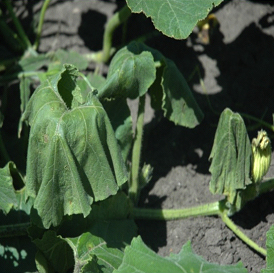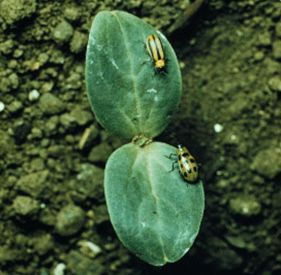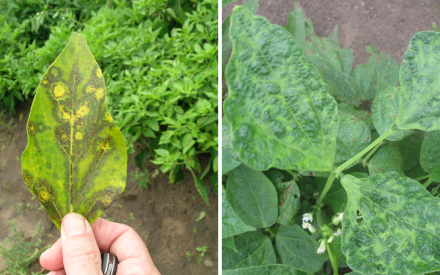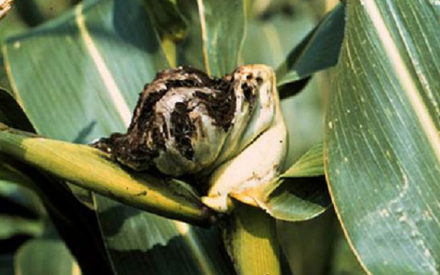
What is bacterial wilt?
Bacterial wilt is a common and destructive disease that affects cucurbits (i.e., plants in the cucumber family), including economically important crops such as melon (Cucumis melo), cucumber (Cucumis sativus) and, to a lesser extent, squash and pumpkin (Cucurbita spp.). This disease is distributed throughout the United States; and can be found anywhere that cucurbits are grown.
What does bacterial wilt look like?
The most distinctive symptom exhibited by a plant with bacterial wilt is wilting and ultimately death. These symptoms are a consequence of the blockage of water movement inside of the plant. Symptoms appear first on leaves of a single runner (vine). Leaves may develop chlorotic (i.e., yellow) and necrotic (i.e., dead) areas as the disease progresses. Symptoms typically develop rapidly along individual runners, and eventually, the plant’s crown is affected, resulting in the entire plant dying. To determine if a symptomatic plant has bacterial wilt, cut a wilted vine near the base of the plant. Next cut a section from this vine and look for sticky threads to form between the two vine sections as you slowly pull them apart. The presence of these sticky threads is diagnostic. This technique works best for cucumbers and melon, but less well for squash and pumpkins.
Where does bacterial wilt come from?
Bacterial wilt of cucurbits is caused by the bacterium Erwinia tracheiphila. This bacterium is moved from plant to plant by two insects: the striped cucumber beetle (Acalymma vittatum) and the spotted cucumber beetle (Diabrotica undecimpunctata). See University of Wisconsin Garden Facts XHT1092, Cucumber Beetles, for details on these insects The bacterium primarily overwinters in the guts of adult beetles, and is released when beetles feed on healthy cucurbit plants and excrete contaminated frass (i.e., feces) onto fresh feeding wounds. E. tracheiphila has been found in association with wild cucurbits and other plants such as goldenrods (Solidago nemoralis and S. altissima), Johnson grass (Sorghum halepense) and even corn (Zea mays). However, most of these plants never show wilt symptoms, and none are considered an important reservoir for the bacterium.
How do I save a plant with bacterial wilt?
Bacterial wilt cannot be controlled once a plant is infected. In particular, chemical sprays are not effective for control once plants show symptoms. If you find bacterial wilt in your garden, immediately remove infected plants, and dispose of them by burning (where allowed by law) or burying them. DO NOT compost infected plants. Prompt removal and disposal of infected plants is important not only because they serve as a source of E. tracheiphila, but because they attract more cucumber beetles, thus increasing the risk of spread of the bacterium to other, healthy plants.
How do I avoid problems with bacterial wilt in the future?
Management of bacterial wilt relies on control of cucumber beetles to prevent infection. Target non-chemical and chemical control methods to protect plants at the beginning of the growing season when plants are more attractive to cucumber beetles. Use mechanical barriers, such as row covers, to protect plants from cucumber beetle feeding. Also, inspect cucurbits on a regular basis for cucumber beetles and their damage (two to three times per week early in the season, and weekly thereafter). When cucumber beetle numbers are high (more than 20 per plant), spray plants with an appropriate insecticide (see UW Garden Facts XHT1092 for recommended insecticides). Be sure to read and follow all label instructions of the insecticide(s) that you select to ensure that you use the insecticide(s) in the safest and most effective manner possible. Cucurbit varieties resistant to bacterial wilt are not currently available. However, some cucurbits such as watermelons and pickling cucumbers tend to be less attractive to cucumber beetles and thus tend to have fewer problems with bacterial wilt. These crops can be used as alternatives to more susceptible cucurbit species.
For more information on bacterial wilt of cucurbits:
Contact the University of Wisconsin Plant Disease Diagnostics Clinic (PDDC) at (608) 262-2863 or pddc@wisc.edu.
Authors: José Pablo Soto-Arias*, UW-Madison Plant Pathology
Last Revised: 02/28/2024
D-number: D0014
*Completed as partial fulfillment of the requirements for Plant Pathology 558 at the University of Wisconsin Madison.
References to pesticide products in this publication are for your convenience and are not an endorsement or criticism of one product over similar products. You are responsible for using pesticides according to the manufacturer’s current label directions. Follow directions exactly to protect the environment and people from pesticide exposure. Failure to do so violates the law.
Thanks to Kimberly Cowles, Amanda Gevens, Kristin Krokowski, Jenna Lind, Dan O’Neil, Isael Rubio-Salaz ar and Tom Wilson for reviewing this document.
A complete inventory of UW Plant Disease Facts is available at the University of Wisconsin-Madison Plant Disease Diagnostics Clinic website: https://pddc.wisc.edu.
Send a Plant Sample for Analysis
Be cautious when self-diagnosing plant health issues. Very few diseases can accurately be diagnosed by eye.
Contact the UW Plant Disease Diagnostics Clinic (PDDC), and for a small fee, clinic staff can examine a plant, determine the cause of the disease/disorder, and provide advice on how to control or prevent the issue.
Download Article





 Cucumber Beetles
Cucumber Beetles Cucumber Mosaic
Cucumber Mosaic Vegetable Disease Quick Reference
Vegetable Disease Quick Reference Powdery Scab
Powdery Scab


